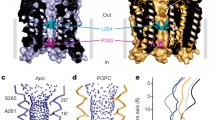Abstract
To further explore the mechanism of selective binding of the representative γ-aminobutyric acid receptors (GABARs) noncompetitive antagonist (NCA) fipronil to insect over mammalian GABARs, three-dimensional models of human α1β2γ2 and house fly β3 GABAR were generated by homology modeling, using the cryo-electron microscopy structure of the nicotinic acetylcholine receptor (nAChR) of Torpedo marmorata as a template. Fipronil was docked into the putative binding site of the human α1β2γ2 and house fly β3 receptors by Surflex-docking, and the calculated docking energies are in agreement with experimental results. The GABA receptor antagonist fipronil exhibited higher potency with house fly β3 GABAR than with human α1β2γ2 GABAR. Furthermore, analyses of Surflex-docking suggest that the H-bond interaction of fipronil with Ala2 and Thr6 in the second transmembrane segment (TM2) of these GABARs plays a relatively important role in ligand selective binding. The different subunit assemblies of human α1β2γ2 and house fly β3 GABARs may result in differential selectivity for fipronil.







Similar content being viewed by others
References
Chebib M, Johnston GA (2000) J Med Chem 43:1427–1447
Bormann J (2000) Trends Pharmacol Sci 21:16–19
Novère NL, Changeux JP (2001) Phil Trans R Soc B 356:1121–1130
Barnard EA, Skolnick P, Olsen RW, Mohler H, Sieghart W, Biggio G, Braestrup C, Bateson AN, Langer SZ (1998) Pharmacol Rev 50:291–314
Burt DR, Kamatchi GL (1991) Faseb J 5:2916–2913
Davies PA, Hanna MC, Hales TG, Kirkness EF (1997) Nature 385:820–823
Whiting PJ, Mcallister G, Vassilatis D, Bonnert TP, Heavens RP, Smith DW, Hewson L, O’Donnell R, Rigby MR, Sirinathsinghji DJS, Marshall G, Thompson SA, Wafford KA (1997) J Neurosci 17:5027–5037
McKerman RM, Whiting PJ (1996) Trends Neurosci 19:139–143
Chang YC, Wang RP, Barot S, Weiss DS (1996) J Neurosci 16:5415–5424
Farrar SJ, Whiting PJ, Bonnert TP, McKernan RM (1999) J Biol Chem 274:10100–10104
Ffrench-Constant RH, Mortlock DP, Shaffer CD, MacIntyre RJ, Roush RT (1991) Proc Natl Acad Sci USA 88:7209–7213
Hosie AM, Aronstein K, Sattelle DB, ffrench-Constant RH (1997) Trends Neurosci 20:578–583
Ffrench-Constant RH, Steichen JC, Rocheleau TA, Aronstein K, Roush RT (1993) Proc Natl Acad Sci USA 90:1957–1961
Casida JE, Tomizawa M (2008) J Pestic Sci 33:4–8
Hawkinson JE, Casida JE (1992) Mol Pharmacol 42:1069–1076
Cole LM, Casida JE (1992) Pestic Biochem Physiol 44:1–8
Ratra GS, Casida JE (2001) Toxicol Lett 122:215–222
SYBYL software, Version 7.3, Tripos Associates, St. Louis, 2006, http://www.tripos.com/
Miyazawa A, Fujiyoshi Y, Unwin N (2003) Nature 423:949–955
Needleman SB, Wunsch CD (1970) J Mol Biol 48:443–453
Zhu ZY, Sali A, Blundell TL (1992) Protein Eng 5:43–51
Jain AN (1996) J Comput Aided Mol Des 10:427–440
Baker D, Sali A (2001) Science 294:93–96
Barnard EA (1996) Trends Pharmacol Sci 17:305–308
Campagna-Slater V, Weaver DF (2007) J Mol Graphics Model 25:721–730
Casida JE, Tomizawa M (2008) J Pestic Sci 33:4–8
Hisano K, Ozoe F, Huang J, Kong X, Ozoe Y (2007) Invert Neurosci 7:39–46
Ratra GS, Kamita SG, Casida JE (2001) Toxicol Appl Pharmacol 172:233–240
Slany A, Zezula J, Tretter V, Sieghart W (1995) Mol Pharmacol 48:385–391
Casida JE, Quistad GB (2004) J Pestic Sci 29:81–86
Chen LG, Durkin KA, Casida JE (2006) Proc Natl Acad Sci USA 103:5185–5190
Ffrench-Constant RH, Anthony N, Aronstein K, Rocheleau T, Stilwell G (2000) Annu Rev Entomol 48:449–466
Acknowledgment
This study was supported by National Natural Science Foundation of China; contract/grant number: 20572084
Author information
Authors and Affiliations
Corresponding author
Rights and permissions
About this article
Cite this article
Cheng, J., Ju, XL., Chen, XY. et al. Homology modeling of human α1β2γ2 and house fly β3 GABA receptor channels and Surflex-docking of fipronil. J Mol Model 15, 1145–1153 (2009). https://doi.org/10.1007/s00894-009-0477-2
Received:
Accepted:
Published:
Issue Date:
DOI: https://doi.org/10.1007/s00894-009-0477-2




